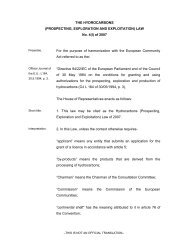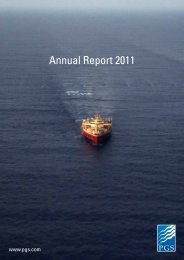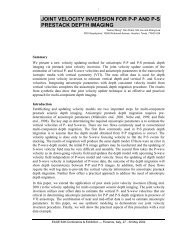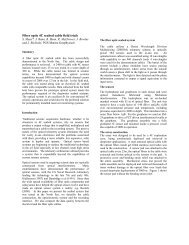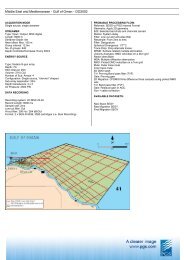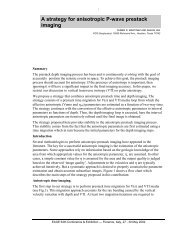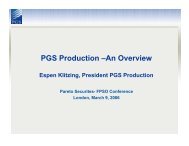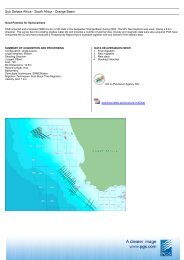OTC 16945 True 3D Data-driven Multiple Removal ... - PGS
OTC 16945 True 3D Data-driven Multiple Removal ... - PGS
OTC 16945 True 3D Data-driven Multiple Removal ... - PGS
You also want an ePaper? Increase the reach of your titles
YUMPU automatically turns print PDFs into web optimized ePapers that Google loves.
<strong>OTC</strong> 3<br />
where only two multiple contributions are available to predict<br />
<strong>3D</strong> multiples for the outer streamers.<br />
It should be noted that for a sailline spacing larger than twice<br />
the streamer separation, the amount of contributions can be<br />
increased artificially by applying some lateral shifts. In this<br />
way, one source of a neighboring streamer will act as<br />
secondary source for the two closest streamers.<br />
It is also remarked that the findings are independent of the<br />
actual streamer spacing as long as the sail line spacing is an<br />
integer multiple of the streamer spacing to obtain a repeatable<br />
pattern. The number of contributions will remain the same;<br />
only the crossline offsets and aperture will change<br />
accordingly.<br />
Finally, for dual source configurations, increasing the spacing<br />
between two sources may lead to a significant increase in both<br />
the aperture and the number of multiple contributions.<br />
However, this only applies to the hypothetical (and extremely<br />
uneconomical) case where the streamer spacing equals the sail<br />
line spacing. By putting both sources on one side of the<br />
streamers, the number of multiple contributions is reduced<br />
considerably. The contributions become very non-symmetric,<br />
which will be non-ideal for any <strong>3D</strong> SRME implementation.<br />
The impact of acquisition on the prediction of <strong>3D</strong> multiples<br />
In this subsection, the impact of the distribution of multiple<br />
contributions on the ability to predict <strong>3D</strong> multiples is<br />
investigated. Because of the simplicity of the model used,<br />
insight is obtained in the general capabilities of interpolation<br />
and/or reconstruction methods to predict <strong>3D</strong> multiples when<br />
only sparse data are available.<br />
In this example, the subsurface model consists of one plane<br />
layer dipping 4 degrees in the crossline direction only. <strong>Data</strong><br />
were modeled for a dual source 16-streamer configuration<br />
with 50 meter streamer separation, with 200 meter and 400<br />
meter sailline separation respectively. Note that for this<br />
streamer configuration, 400 meter sail line spacing gives<br />
conventional sub-surface coverage with no duplication in the<br />
crossline direction. Figure 5a shows the ideal crossline<br />
multiple contribution gather for a source and receiver<br />
combination with 0 meter inline offset and 12.5 meter<br />
crossline offset. Figures 5b-c show, for the same source and<br />
receiver combination, the 7 and 3 crossline multiple<br />
contributions available for a 200 and 400 meter sailline<br />
separation respectively. Figure 6a shows a common shot<br />
gather for the inner streamer, and Fig. 6b shows the<br />
corresponding multiples, predicted using a 2D SRME<br />
approach. Figure 6c shows the ideal <strong>3D</strong> multiples, and Figs.<br />
6d-e show the reconstructed multiples from the 200 and the<br />
400 meter sailline configuration respectively. Note that for<br />
both configurations, the <strong>3D</strong> multiples were reconstructed<br />
satisfactory. Figures 7 and 8 shows the same results for the<br />
outer streamer. Note from Fig. 7b-c that the 5 contributions<br />
from the 200 meter sailline configuration (spaced at –362.5, –<br />
212.5, –162.5, –12.5 and 37.5 meters) are more equally<br />
distributed in the crossline direction than the 3 contributions<br />
from the 400 meter sailline configuation (spaced at –362.5, –<br />
12.5 and 37.5 meters). From Fig. 8b it can be seen that the 2D<br />
multiples are predicted too late in time. Also note that the<br />
results for the 200 meter sailline separation, shown in Figure<br />
8d, are significantly better then for the 400 meter separation<br />
shown in Figure 8e. This is due both to the increased number<br />
of contributions available (5 contributions for the 200 meter<br />
sailline separation versus 3 for the 400 meter separation), and<br />
the better distribution of the multiple contributions over the<br />
total aperture from the 200 meter configuration. However, for<br />
the data with 400 meter sailline separation, the second<br />
multiple is predicted much better than with 2D SRME, and<br />
although the wavelet of the first multiple is distorted, the<br />
timing is good. Therefore we would still expect <strong>3D</strong> SRME to<br />
perform better than 2D SRME, even for the outer streamer.<br />
Recommendations for acquisition<br />
In <strong>3D</strong> data-<strong>driven</strong> multiple removal, the multiple contributions<br />
(defined as locations where both receiver and source data are<br />
available) are the only data available to predict the <strong>3D</strong><br />
multiples. Hence, the distribution of multiple contributions<br />
will govern the quality of the final predicted <strong>3D</strong> multiple trace.<br />
Results from synthetic modeling indicate that a denser grid of<br />
multiple contributions leads to a better prediction of the <strong>3D</strong><br />
multiples.<br />
During marine acquisition, the distribution of the crossline<br />
multiple contributions can be optimized for the application of<br />
<strong>3D</strong> SRME by<br />
• Shooting overlap (by increasing the number of streamers<br />
while keeping the sailline spacing constant);<br />
• Decreasing the sailline spacing;<br />
• Keeping the sailline spacing an integer multiplication of<br />
the streamer spacing;<br />
• Increasing the spread length<br />
For a more complex subsurface, it is therefore recommended<br />
to create a dense grid of multiple contributions with sufficient<br />
aperture to reconstruct the full complexity of the <strong>3D</strong> multiples<br />
successfully.<br />
A processing strategy for <strong>3D</strong> SRME<br />
This section describes an efficient processing sequence to<br />
apply <strong>3D</strong> SRME in a production environment. A three-step<br />
sequence is proposed to predict and remove <strong>3D</strong> multiples for<br />
each sail line using only the recorded data around the output<br />
streamer. Even though the proposed sequence will benefit<br />
from any form of acquisition optimization, the strategy is<br />
designed to handle <strong>3D</strong> data sets that were acquired from<br />
conventional marine acquisition. The three steps involved are<br />
discussed in the following three subsections.<br />
Step 1: Pre-processing<br />
The pre-processing sequence starts with an analysis of the<br />
navigation data to investigate the positioning of the source and<br />
receivers. When irregularities (due to feathering and other<br />
positioning errors, such as drop-outs) are severe, wavefield<br />
regularization should be applied as part of the pre-processing<br />
sequence to position sources and receivers onto a regular pre-



